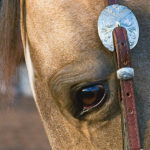When temperatures drop from the merely crisp to the downright cold, don’t cancel your riding plans out of concern for your horse’s health. Most horses can be safety ridden in the winter if you keep in mind the following guidelines:

• Footing can be especially treacherous in cold weather. Frozen footing can feel like concrete under a horse’s hooves, and mud that is churned up and then freezes solid can twist joints and bruise feet. Watch to see if you horse leaves hoof prints in the turf you’re traveling over. If he doesn’t, the ground has no “give” and you’ll want to stick to a walk.
• Cold air can worsen respiratory issues. Some studies have shown that extremely frigid air—in the single digits—can lead to minor inflammation in the lungs. If your horse is already dealing with a flare-up of recurrent airway obstruction (also called heaves) cold air could exacerbate the situation —you’ll want to skip the below-freezing rides until he’s breathing easier. But resist the urge to shut him up in the barn to “protect” his lungs: The dust and ammonia fumes inside will be far more damaging than any cold, fresh air.
• Proper warm ups take longer in cold weather. Cold weather necessitates taking a few minutes more at the start of your ride to prepare tendons, ligaments and cartilage for the work ahead. Warming up heats crucial structures by increasing blood flow, a process that will take longer if you are starting at lower temperatures. Stick to the walk and slow trots, with gentle bending and stretching exercises, for about twice as long as you might in the summer. Keep in mind that a horse with arthritis is going to feel stiffer in the cold air. This stiffness, however, will resolve with a careful, gradual warm-up. If your arthritic horse doesn’t improve over the first 20 minutes of a ride, the problem isn’t the temperature. Call your veterinarian to discuss a more aggressive arthritis-management strategy.
This article first appeared in EQUUS issue #446, November 2014.
Save






